This book is the result of almost 50 years of world travel by the author who, under the title of Lost Railways of the World, describes his “Top Ten”, and many other quirky lines that are a mystery why they were ever built in the first place
Published in November 2022 as part of Pen & Sword‘s “Train Craft” series and written by Nigel Welbourn, the book measures around 21.59 cm x 28.58 cm and has 256 pages and 300 colour illustrations. It has a published price of £40, but at the time of writing Pen & Sword has it on offer online for £28.00 and it can be obtained from Amazon for £23.50
This book follows the author’s lifelong interest in disused railways where he has written 16 volumes on lost lines in various parts of the UK. Now his numerous trips around the world has resulted in a remarkable book. Twenty-seven chapters are grouped by region, starting in Europe followed by The Middle East, The Americas, Asia, Africa, and Oceania, divided by country or region, with each region including separate chapters for different countries within the region.
The author’s informative text records the fortunes of lost railways in every country with significant disused railways, from the hottest African desert to the coldest steppes of Russia. It has a surprisingly British flavour as historically many railways throughout the world used British equipment and operating practices.
An alternative title for the book could well have been the Guinness Book of Lost Railways of the World, as it describes some of the world’s oldest, largest, longest, most northerly, southerly, expensive, most crooked, steepest, highest, lowest and most-notorious lost railways.
As well as lost railways there are tales of unusual ones, such as a disappearing phantom bridge, a line destroyed by molten lava one that sank under the sea, and another that conveyed giant turtles.
It is not only lost railways that are subjects, as the author describes his hunt in Argentina for the ex-Lynton & Barnstaple Railway locomotive Lew following its mysterious disappearance after being exported to the country.
There’s no doubt that a closed line on the island of Spitsbergen, at 78 degrees north and halfway between Norway and the North Pole, will qualify as the world’s most northerly lost railway. Although the line is now closed, a locomotive and wagons still remain as seen in the left below. New bridges often make railway infrastructure redundant, such as the building on the right below which served the port of Copenhagen before a fixed link was opened between Sweden and Denmark.
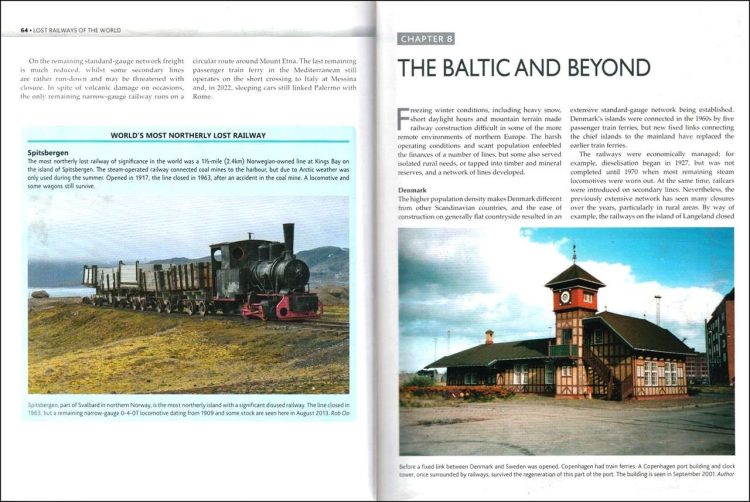
It is arguable whether the bridge on the left below qualifies for inclusion in the book as it is now destined for a new lease of life. In 2014 excavation began on a second channel of the Suez Canal, which isolated the railway leading up to the bridge. However, a decision was taken to build a bridge across the new, shipping channel, and to bring the existing bridge back into use.
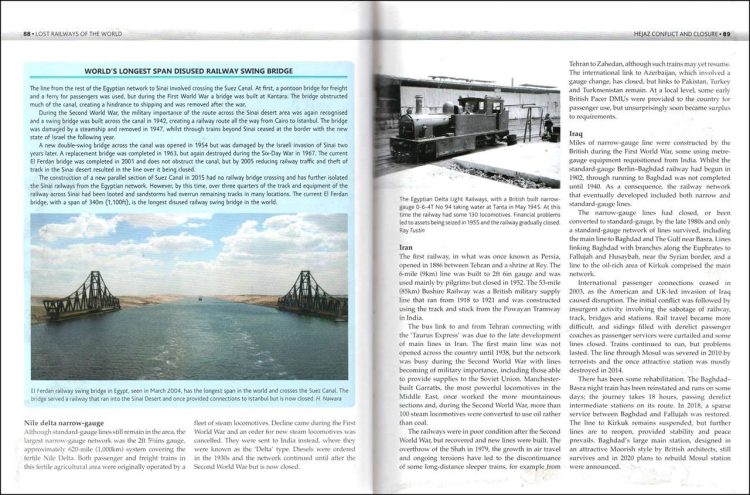
The Hejaz Railway achieved fame as it was featured in the film Lawrence of Arabia, one of his victims being the derailed locomotive seen at the bottom right below. It ran from Damascus in Syria through Jordan to Medina in Saudi Arabia. Unsurprisingly, political turmoil in the region has caused problems for the line although proposals have been put forward to reopen parts of the line.
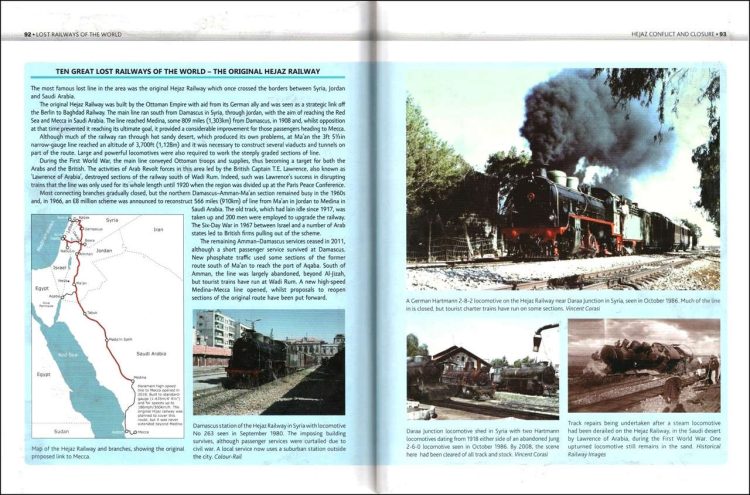
Many lines in North America have closed, and one of the most impressive was the 300-mile-long Kettle Valley Railway in British Columbia. It was built through spectacular mountain scenery, had steep gradients, a spiral tunnel and an enormous loop, tunnels cut through solid rock, and trestle bridges over a hundred feet in height. On the left below is one of many snippets of railway world records with a paragraph describing the world’s smallest commercially operated closed railway.
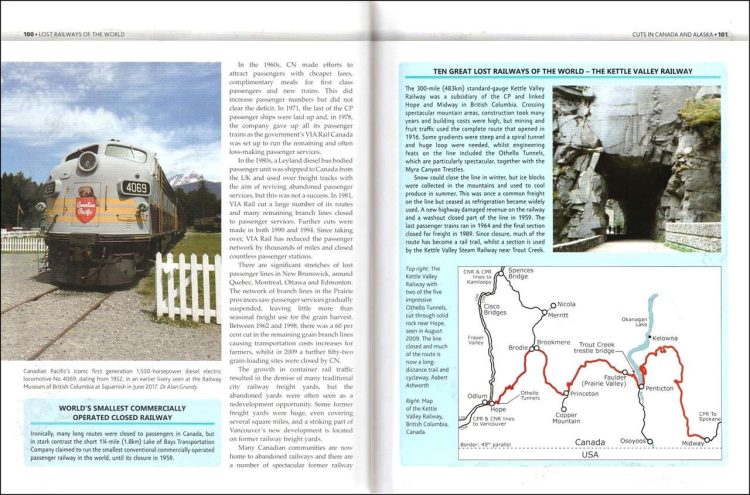
It seems incredible that anyone would contemplate building a railway across the Gulf of Mexico to the Florida Keys, but in 1912 a 127-mile-long line was completed from Homestead in south Florida across an amazing number of bridges to Key West. The longest bridge was 7 miles in length.
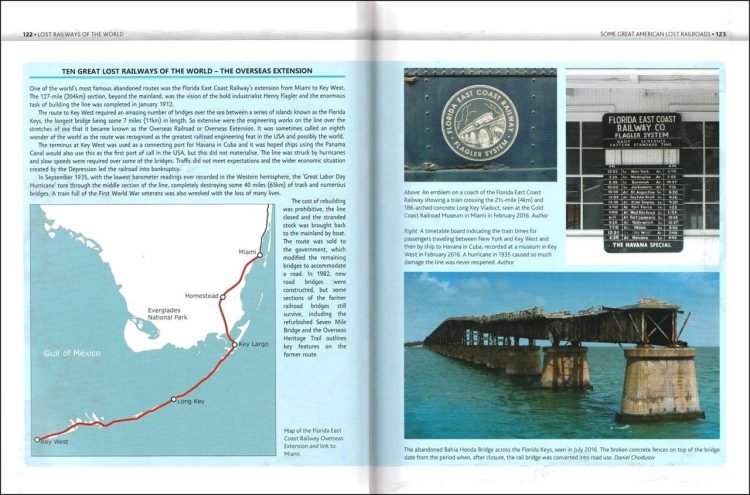
In the heart of the high-altitude Atacama Desert in southern Bolivia is the “World’s Most Unusual Desert Graveyard”, where 18 steam locomotives including some heavy-duty Garratts and assorted rolling stock have been left to the ravages of salt-laden winds from the adjoining salt plain. They were abandoned due to the collapse of the mining industry and[political issues with adjoining countries.
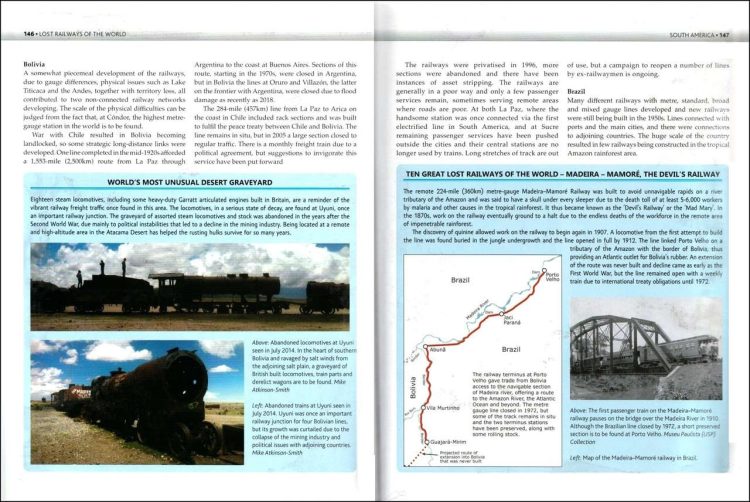
The author’s source information comes from his own visits to each country in the book, and shines through in his excellent narrative.
To choose the Top Ten Great Lost Railways of the World must have been a challenge, but the ones chosen seem to justify their epithet, especially as the British contribution is understandably the Great Central Main Line. Railways through landscapes as diverse as the Florida Keys and the Khyber Pass are also obvious candidates for the “Top Ten”, each of which is accompanied by a map.
As well as the Top Ten railways, the author’s use of Guinness Book of World Records-style snippets takes this from a book for railway enthusiasts to one that anyone can enjoy, and dip in and out of at any time.
To name but a few, there are such odd topics as the “World’s first hydro-electric lost railway”, “World’s lowest-altitude lost railway”, “World’s most imposing lost station building”, “World’s largest disused curved wooden trestle”, “World’s most crooked lost line”, and “World’s Most Southerly”, “Highest”, and “Shortest Lived” lost lines.
But what makes the book even more interesting are other snippets, such as “The World’s most spectacularly positioned bridge”, and the “World’s most unusual railway monument to an elephant.
The fortunes of those lines are described in an eminently readable style that covers every country that has significant disused railways, many of them using British equipment and practices.
The book will delight not only the railway enthusiast but will also appeal to others with an interest in nostalgia, history, and geography, The book is produced to Pen & Sword’s usual high standard and is highly recommended.
The book is available to purchase from Amazon and from Pen & Sword.
RailAdvent would like to thank Pen & Sword for providing is with a copy of the book for review.






Responses